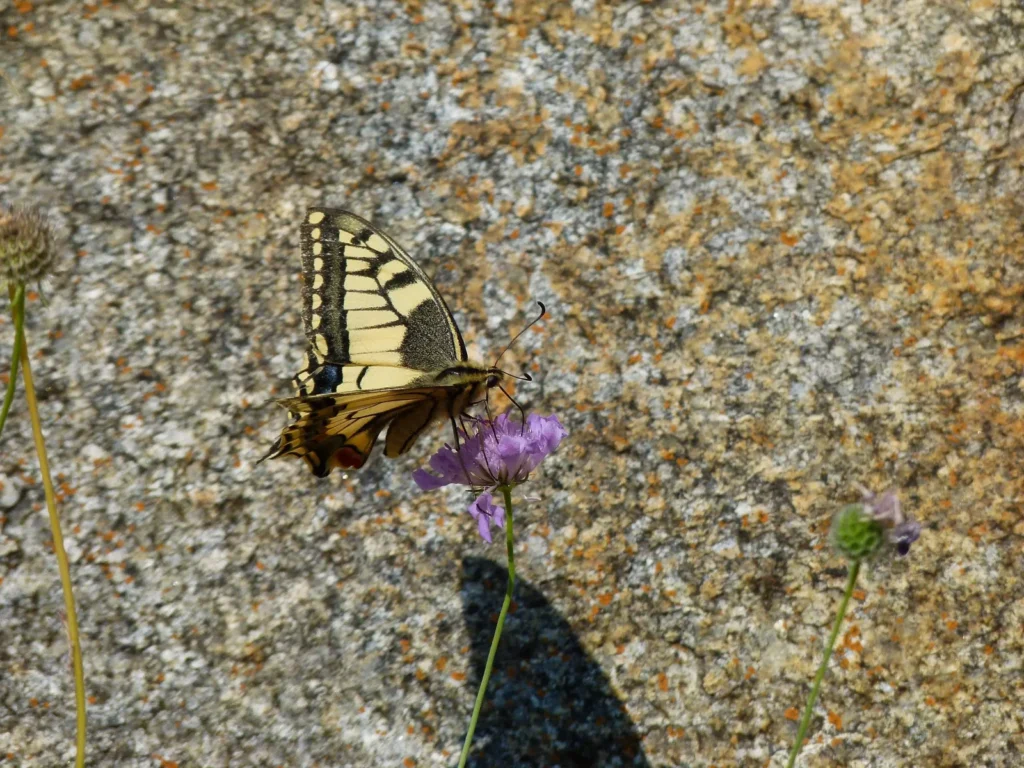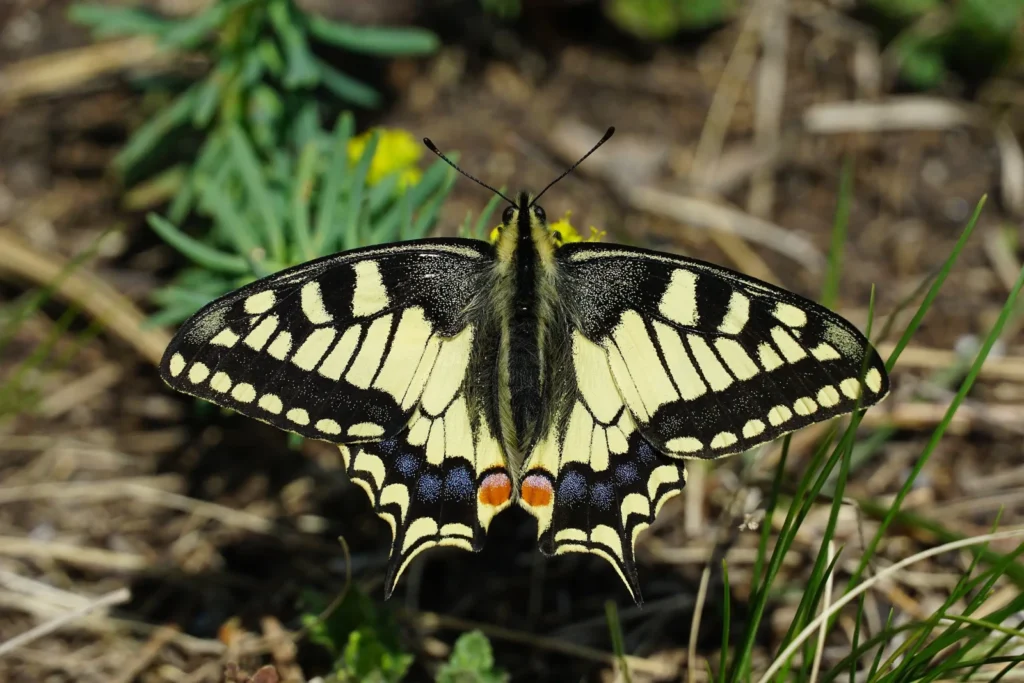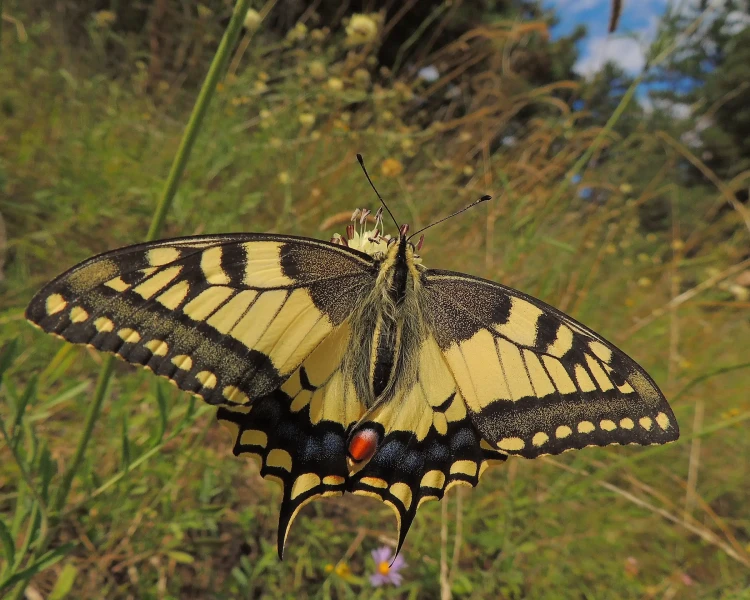Swallowtail (Papilio machaon) – one of the most beautiful and famous butterflies in Europe and Asia. Its bright coloring, elegant forms and graceful flight make it a real decoration of nature.
This butterfly got its name in honor of Swallowtail, a legendary ancient Greek physician, son of Asclepius. Swallowtail belongs to the family sailboats (Papilionidae) and it is one of the largest representatives of diurnal butterflies in Europe.
In this article, we will look at biology of the swallowtail, its life cycle, habitat, food habits, natural enemies, conservation methods and interesting facts.

Scientific classification
🔬 Classification of swallowtail:
✔ The Kingdom: Animals (Animalia)
✔ Type: Arthropods (Arthropoda)
✔ Class: Insects (Insecta)
✔ Row: Lepidoptera (Lepidoptera)
✔ Family: Sailboats (Papilionidae)
✔ Gender: Papilio
✔ View: Swallowtail (Papilio machaon)
📌 Interesting!
There are more than 550 types of sailboats, but the swallowtail – the most common one among them.
Appearance and features of the structure
Makhaon – big and bright butterfly, which is easily recognizable due to its unique color scheme.
, Main Features
✔ Wingspan: 7-10 cm
✔ Color scheme: yellow-black with blue and red flecks
✔ Wing shape: elongated, with "tails"
✔ Oko: large, black, folding
✔ Tentacle: long, club-shaped hair
✔ Body: covered with fine hairs
🔹 Key features of painting:
✅ Bright yellow background wings
✅ Black stripes in the form of lace
✅ Blue stripe closer to the lower edge of the hind wings
✅ Red spot near the "tail" on each rear wing
📌 Interesting!
Due to the long "tails" on the hind wings of the swallowtail, it is often compared with by sailboatWhich gave his family its name – Sailboats (Papilionidae).
Habitat and distribution
🌍 Where does the swallowtail live?
Makhaon – widespread species, which occurs on different continents.
✅ Distribution regions:
• Europe - Ukraine, Poland, France, Germany
• Asia - China, Japan, Kazakhstan
• North America - USA, Canada
• Africa - Morocco, Egypt
• Siberia and the Far East
🔹 Typical habitats:
Л Meadows, steppes, fields
✅ Forest edges, forest clearings
Альп Alpine meadows (up to 3000 m above sea level)
✅ Gardens, vegetable gardens
📌 Interesting!
The swallowtail adapts perfectly to various conditions – from arid steppes to moist forests and mountain slopes.

Life cycle and reproduction
Swallowtail passes four stages of developmentwhich together last from 1.5 to 2 months.
Стадії стадии развития:
✅ Egg - 7-14 days
✅ Caterpillar - 3-4 weeks
✅ Pupa - 2-3 weeks (can winter)
✅ Imago (adult butterfly) - lives 2-4 weeks
🔹 How does the swallowtail breed?
✔ Females lay eggs up to 100-150 eggs one per leaf of the host plant
✔ After a week they appear trackswho are actively eating
✔ The caterpillar passes by 5 lines, reaching the length of up to 5 cm
✔ Before pupation, the caterpillar changes color to brown or green
✔ The pupa can overwinter, and in the spring it flies out of it a new generation of butterflies
📌 Interesting!
The swallowtail caterpillar has a unique defense mechanism – osmetery. This is bright orange fork organwhich emits a pungent smell, scaring off predators.
Food habits and role in nature
What does the swallowtail eat?
✅ Caterpillar: it feeds on plants of the umbrella family-carrots, dill, parsley, fennel
✅ Imago (adult butterflies): flower nectar-clover, thistle, lavender, dandelion
🔹 What benefits does the swallowtail bring?
✔ Pollinates flowers, promoting plant reproduction
✔ Regulates the population of umbrella plantsby eating them with a caterpillar
✔ There are an important element of the food chain
📌 Interesting!
Adult swallowtail drinks nectar, use long proboscis (up to 2 cm).

Natural enemies and threats
🔹 Who hunts the swallowtail?
✅ Birds-swallows, sparrows, tits
Parasitic wasps-lay their eggs in the caterpillar
Па Spiders-catch in the web
Мелкие Small mammals-hedgehogs, shrews
🔹 Main threats:
⚠ Destruction of the natural environment (plowing meadows)
⚠ Use of pesticides in agriculture
⚠ Air and water pollution
📌 Interesting!
In some countries, the swallowtail is protected and listed The Red Book.
Interesting facts about the swallowtail
✔ The swallowtail is one of the largest diurnal butterflies in Europe
✔ It can fly up to 20 km per day in search of food
✔ Its caterpillar is non-venomous, although the bright color disguises it as dangerous
✔ Swallowtail lived in the age of dinosaurssupporting fossilized remains
Conclusion
Swallowtail (Papilio machaon) – a perfect example of the harmony of nature, a symbol of beauty and grace. It plays an important role in nature and needs protection from human activity.
📢 Let's save these beautiful butterflies for future generations!